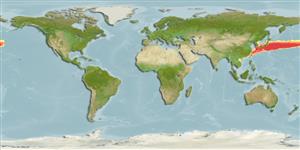Klassifizierung / Names
Namen | Synonyme | Catalog of Fishes(Gattung, Arten) | ITIS | CoL | WoRMS | Cloffa
>
Stomiiformes (Lightfishes and dragonfishes) >
Stomiidae (Barbeled dragonfishes) > Melanostomiinae
Etymology: Eustomias: Greek, eu = good + Greek, stoma = mouth (Ref. 45335).
Environment: milieu / climate zone / depth range / distribution range
Ökologie
seewasser bathypelagisch; tiefenbereich 0 - 932 m (Ref. 34246). Deep-water
Northwest Pacific: southeast of Japan.
Size / Gewicht / Alter
Maturity: Lm ? range ? - ? cm
Max length : 12.1 cm SL Männchen/unbestimmt; (Ref. 34246); 12.1 cm SL (female)
Kurzbeschreibung
Bestimmungsschlüssel | Morphologie | Morphometrie
The single-based branch of the barbel arises from the stem; the branch with many elaborate, branched side filaments throughout most of its length with the proximal filaments arising just distal to the main branch origin. Most of the barbel stem unpigmented between branch and terminal bulb (Ref. 34246).
Life cycle and mating behavior
Maturities | Fortpflanzung | Spawnings | Egg(s) | Fecundities | Larven
Clarke, T.A., 1999. Pelagic fishes of the genus Eustomias (Melanostomiidae) similar to Eustomias dendriticus Regan and Trewavas with the description of seven new species. Copeia 1999(4):1002-1013. (Ref. 34246)
IUCN Rote Liste Status (Ref. 130435)
Bedrohung für Menschen
Harmless
Nutzung durch Menschen
Tools
Zusatzinformationen
Download XML
Internet Quellen
Estimates based on models
Preferred temperature (Ref.
123201): 0.9 - 18.7, mean 11.5 °C (based on 63 cells).
Phylogenetic diversity index (Ref.
82804): PD
50 = 0.5000 [Uniqueness, from 0.5 = low to 2.0 = high].
Bayesian length-weight: a=0.00302 (0.00117 - 0.00783), b=3.12 (2.89 - 3.35), in cm total length, based on LWR estimates for this (Sub)family-body shape (Ref.
93245).
Trophic level (Ref.
69278): 4.1 ±0.7 se; based on size and trophs of closest relatives
Widerstandsfähigkeit (Ref.
120179): mittel, Verdopplung der Population dauert 1,4 - 4,4 Jahre. (Assuming tmax>3).
Fishing Vulnerability (Ref.
59153): Low vulnerability (10 of 100).
